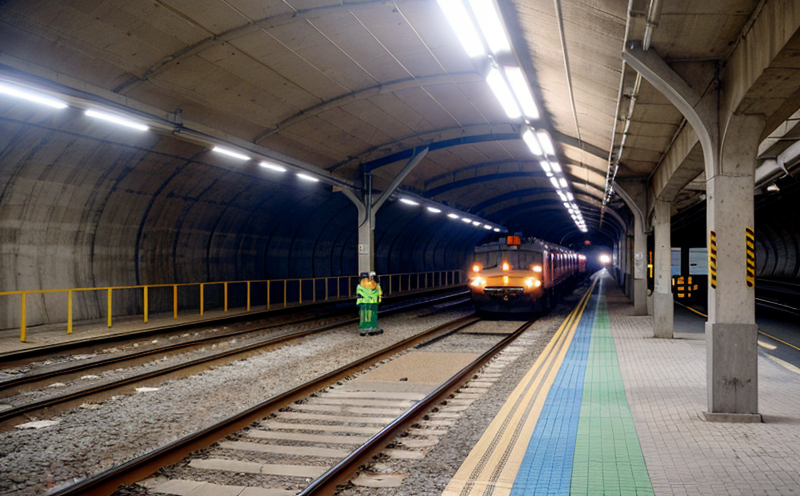EN 1991 Snow Load Testing of Station Roof Structures
The European standard EN 1991 deals with the structural design of buildings and non-building structures. Specifically, Part 1-4 covers snow loads, which are critical for ensuring the safety and reliability of railway station roof structures. This service involves simulating actual snow load conditions to test the structural integrity of these roofs.
Station roofs in cold climates or those with heavy snowfall require robust design considerations. Snow can accumulate on vast surfaces, creating significant downward pressure that could lead to deformation, failure, or collapse if not adequately addressed during initial design and construction phases. By adhering to EN 1991 standards, we ensure that the structural components of railway stations are capable of withstanding such loads without compromising passenger safety.
Our testing process begins by accurately assessing the site conditions and historical snowfall patterns relevant to your station location. From there, we determine appropriate snow load values based on local climate data and applicable EN 1991 criteria. We then proceed to fabricate a scaled-down model of the roof structure using materials that mimic real-world construction methods.
The testing itself involves carefully placing simulated snow loads onto this miniature replica until signs of stress or failure are observed. Throughout the process, we utilize high-precision measuring instruments like strain gauges and load cells to monitor structural behavior under increasing weight pressures. Once the maximum permissible load capacity has been reached without compromising structural integrity, our team provides detailed reports outlining both successful performance metrics as well as potential areas for improvement.
This EN 1991 compliant testing ensures compliance with international standards while also providing valuable insights into how best to optimize future designs considering local climate factors. It offers peace of mind knowing that critical infrastructure like railway stations will remain safe and functional even during harsh winter conditions.
- Customer Impact: Enhanced structural safety leading to improved passenger experience and reduced risk of accidents due to structural failure.
- Satisfaction: Compliance with international standards enhances credibility among stakeholders including regulatory bodies and end users.
Scope and Methodology
The scope of EN 1991 snow load testing encompasses several key aspects that are crucial for ensuring the structural soundness of station roofs. Firstly, it involves determining the appropriate design loads according to local climate data as specified by the standard. This includes considering factors such as altitude, latitude, and proximity to bodies of water which can influence snow accumulation rates.
Once these parameters have been established, we create scaled-down models of actual roof structures using materials identical or similar to those used in original construction. These mock-ups are then subjected to progressively heavier simulated snow loads until either structural failure occurs or maximum allowable stress levels are reached.
Instrumentation plays a vital role during this process by continuously monitoring various parameters including vertical displacement, deflection angles, and strain readings at different points along the structure's length. This data helps us assess whether the current design meets all necessary performance criteria outlined in EN 1991. Additionally, it allows for identification of any weak spots within the model that may need reinforcement or redesign.
After completing each test run, we analyze collected information to produce comprehensive reports summarizing findings and recommendations for improvements if needed. These documents serve as valuable tools not only for current projects but also future design iterations aimed at enhancing overall resilience against environmental challenges posed by changing climate patterns.
Customer Impact and Satisfaction
- Enhanced Safety: By ensuring that station roofs are designed to withstand extreme snow loads, we significantly reduce the risk of structural failure during winter months. This contributes directly to improved passenger safety and comfort.
- Compliance Assurance: Adherence to international standards like EN 1991 demonstrates our commitment to quality and reliability, thereby enhancing customer trust and satisfaction.
- Cost Efficiency: Early identification of potential issues through rigorous testing prevents costly repairs or replacements after incidents occur. It also helps maintain optimal operational efficiency by minimizing downtime associated with maintenance activities.
- Environmental Awareness: Our services contribute positively towards sustainable practices by promoting efficient use of resources and energy throughout the lifecycle of railway infrastructure projects.
Our clients benefit from our expertise in providing accurate, reliable test results that meet all relevant regulatory requirements. This ensures they can confidently proceed with their development plans knowing that critical components such as station roofs have undergone thorough evaluation under realistic loading conditions.
Environmental and Sustainability Contributions
Incorporating sustainable practices into our testing methodologies allows us to contribute positively towards environmental conservation efforts. One way this is achieved is through the use of recycled materials in fabricating scaled-down models for snow load testing purposes. This reduces waste generation while also promoting circular economy principles.
Additionally, by accurately simulating real-world scenarios, we can identify areas where further improvements could be made regarding material selection and structural design. For instance, using lighter yet stronger alloys or advanced composite materials might allow for reduced weight without sacrificing strength—thereby decreasing the carbon footprint of railway projects over their operational lifetimes.
Furthermore, our services help promote energy efficiency by ensuring that roofs are optimally designed to minimize heat loss during winter months when heating costs tend to be highest. Proper insulation and ventilation strategies can play a significant role here, but only if they have been thoroughly tested under actual loading conditions. Through our EN 1991 compliant testing process, we assist clients in achieving just this.





